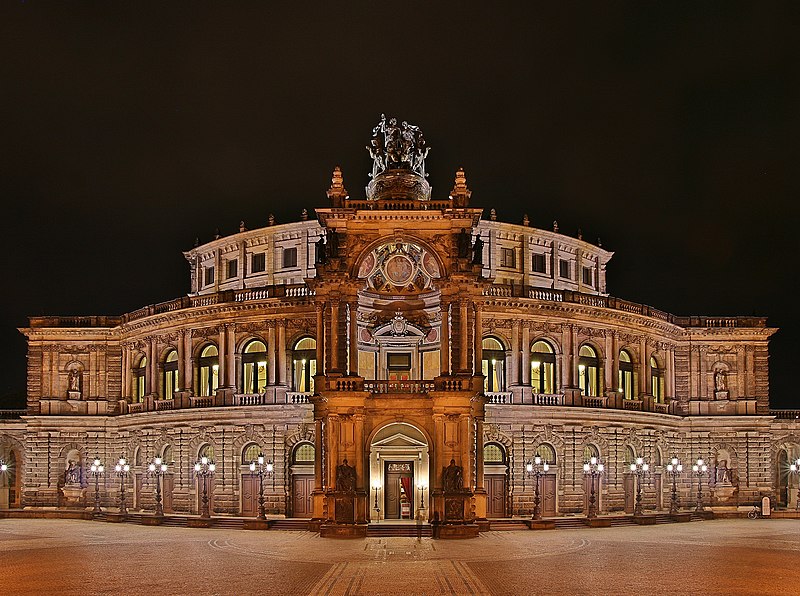Αρχιτέκτονες που θαύμαζε ο Χίτλερ
βιβλιογραφία
Albert Speer (1971). INSIDE THE THIRD REICH. N.Y N.Y. Avon Books
South façade of the Opéra Garnier in Paris 1861-75
Charles Garnier
Palais Garnier
Grand escalier d'honneur
"... η σκάλα της είναι η ομορφότερη του κόσμου. Όταν οι κύρίες με τις ακριβές τουαλέτες τους που συνοδεύονται από ένστολους κυρίους κατεβαίνουν τα σκαλιά της - κύριε Σπέερ, πρέπει να χτίσουμε κι εμείς κάτι τέτοιο."
Südwestansicht der Wiener Staatsoper
1861
im Stil der Neorenaissance
August Sicard von Sicardsburg &
Eduard van der Nüll
"ο Εδουάρδος ντερ Νιλ νόμιζε ότι η όπερα ήταν αποτυχία. Αυτοκτόνησε απελπισμένος την ημέρα των εγκαινίων της."
Their design failed to match the monumentality of the Heinrichshof opposite (destroyed in World War II, and in 1955 replaced by the Opernringhof). Criticism from both the Emperor and a press campaign against the pair of architects described the disappointment of the Viennese public and suggested that the building was merely a half-success. After the street level in front of the opera house was raised by a metre, the opera was described as the "sunken chest" and - in analogy to the military disaster of 1866 - "the Königgratz of Construction".
Eduard van der Nüll was deeply troubled by the criticism and hanged himself on 4 April 1868. His partner Sicardsburg died nearly 10 weeks later, diagnosed with tuberculosis. It was said that the Emperor had been so shocked by the suicide of Eduard van der Nüll, that from then on he responded to all new art phenomena with the standard phrase, "It was very beautiful, I liked it a lot".
Rear of the Vienna State Opera, showing the stage wings
A marble staircase between the main entrance and the first floor
Vienna State Opera
Stadttheater am Theaterplatz 4,
Innere Stadt von Klagenfurt
Hermann Helmer
Das Große Haus ist die Hauptspielstätte
des Vierspartenhauses Theater Augsburg.
Ferdinand Fellner & Hermann Helmer
Eidgenössische Technische Hochschule Zürich
ομοσπονδιακό πολυτεχνείο Ζυρίχης
Gottfried Semper
The Semper Opera in Dresden
Gottfried Semper
Joseph Poelaert
At the centre of the building looking upwards towards the dome
Justitiepaleis Brussel
Hof van Cassatie, Justitiepaleis Brussel
αίθουσα δικαστηρίου
Braunes Haus
γραφεία του εθνικοσοσιαλιστικού κόμματος από το 1930
μετατροπή από τον Paul Troost
Situated between Karolinenplatz and Königsplatz the mansion was built in 1828 by Jean Baptiste Métivier in neo-classicism style for the aristocrat Karl Freiherr von Lotzbeck. Since 1876 the building was known as "Palais Barlow".
Funds for renovation were provided by industrialist Fritz Thyssen. The house was converted from an urban villa to an office building by the architect Paul Troost. He and Adolf Hitler also re-decorated it in a heavy, anti-modern style. Early Hitler biographer, Konrad Heiden, claims that it was during the renovation of the Brown House, that Hitler "for the first time in his life" was able to "abandon himself to his passion for building and designing."
Albert Speer (1971). INSIDE THE THIRD REICH. N.Y N.Y. Avon Books
South façade of the Opéra Garnier in Paris 1861-75
Charles Garnier
Palais Garnier
Grand escalier d'honneur
"... η σκάλα της είναι η ομορφότερη του κόσμου. Όταν οι κύρίες με τις ακριβές τουαλέτες τους που συνοδεύονται από ένστολους κυρίους κατεβαίνουν τα σκαλιά της - κύριε Σπέερ, πρέπει να χτίσουμε κι εμείς κάτι τέτοιο."
Südwestansicht der Wiener Staatsoper
1861
im Stil der Neorenaissance
August Sicard von Sicardsburg &
Eduard van der Nüll
"ο Εδουάρδος ντερ Νιλ νόμιζε ότι η όπερα ήταν αποτυχία. Αυτοκτόνησε απελπισμένος την ημέρα των εγκαινίων της."
Their design failed to match the monumentality of the Heinrichshof opposite (destroyed in World War II, and in 1955 replaced by the Opernringhof). Criticism from both the Emperor and a press campaign against the pair of architects described the disappointment of the Viennese public and suggested that the building was merely a half-success. After the street level in front of the opera house was raised by a metre, the opera was described as the "sunken chest" and - in analogy to the military disaster of 1866 - "the Königgratz of Construction".
Eduard van der Nüll was deeply troubled by the criticism and hanged himself on 4 April 1868. His partner Sicardsburg died nearly 10 weeks later, diagnosed with tuberculosis. It was said that the Emperor had been so shocked by the suicide of Eduard van der Nüll, that from then on he responded to all new art phenomena with the standard phrase, "It was very beautiful, I liked it a lot".
Rear of the Vienna State Opera, showing the stage wings
A marble staircase between the main entrance and the first floor
Vienna State Opera
Stadttheater am Theaterplatz 4,
Innere Stadt von Klagenfurt
Hermann Helmer
Das Große Haus ist die Hauptspielstätte
des Vierspartenhauses Theater Augsburg.
Ferdinand Fellner & Hermann Helmer
Eidgenössische Technische Hochschule Zürich
ομοσπονδιακό πολυτεχνείο Ζυρίχης
Gottfried Semper
The Semper Opera in Dresden
Gottfried Semper
Palais de justice de Bruxelles
Justitiepaleis van Brussel
Joseph Poelaert
At the centre of the building looking upwards towards the dome
Justitiepaleis Brussel
Hof van Cassatie, Justitiepaleis Brussel
αίθουσα δικαστηρίου
Braunes Haus
γραφεία του εθνικοσοσιαλιστικού κόμματος από το 1930
μετατροπή από τον Paul Troost
Situated between Karolinenplatz and Königsplatz the mansion was built in 1828 by Jean Baptiste Métivier in neo-classicism style for the aristocrat Karl Freiherr von Lotzbeck. Since 1876 the building was known as "Palais Barlow".
Funds for renovation were provided by industrialist Fritz Thyssen. The house was converted from an urban villa to an office building by the architect Paul Troost. He and Adolf Hitler also re-decorated it in a heavy, anti-modern style. Early Hitler biographer, Konrad Heiden, claims that it was during the renovation of the Brown House, that Hitler "for the first time in his life" was able to "abandon himself to his passion for building and designing."


.JPG/800px-Wien_-_Staatsoper_(1).JPG)



.JPG/800px-Gro%C3%9Fes_Haus_(Augsburg).JPG)







Σχόλια
Δημοσίευση σχολίου